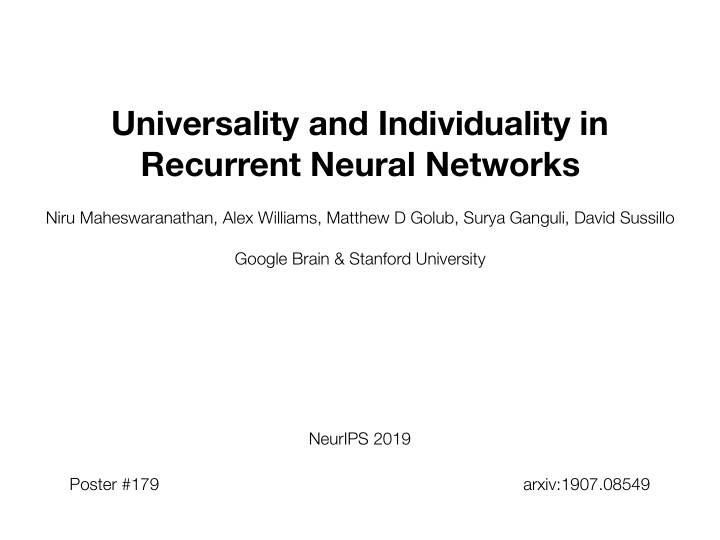



Universality and Individuality in Recurrent Neural Networks Niru Maheswaranathan, Alex Williams, Matthew D Golub, Surya Ganguli, David Sussillo Google Brain & Stanford University NeurIPS 2019 Poster #179 arxiv:1907.08549
Artificial neural networks in neuroscience Advantages: Can train ANNs to accomplish tasks analogous to those studied in animals. • Can inspect/probe/dissect artificial networks very easily. • Can easily initiate a huge number of in silico studies • ... Poster #179 arxiv:1907.08549
Artificial & biological neural networks Motion context a b c Dots off Line Rotate Sort by attractor Attractor irrelevant Dots colour Dots on off Motion Colour Colour 1 Choice 1 Choice 2 Choice 1 Choice 2 Choice 1 Choice 2 6 Choice Choice Choice Motion Colour Strong Weak Strong Strong Weak Strong To choice 1 To choice 2 To choice 1 To choice 2 Colour context Motion context a b c Maheswaranathan et al, 2018 Sort by irrelevant colour Choice Rotate axis Dots Dots on off Dots a c Units off Motion Colour Colour 1 Go Unit 145 Go 1 Yamins & DiCarlo, 2014 RT Go Activitity (a.u.) 1.0 1.5 Dly Go Choice 1 Choice 2 Choice 1 Choice 2 Choice 1 Choice 2 Anti Choice Choice Choice 0.5 RT Anti Dly Anti Normalized task variance Motion Colour 0.0 DM 1 Strong Weak Strong Strong Weak Strong DM 2 0.0 Time (s) 1.5 Ctx DM 1 To choice 1 To choice 2 To choice 1 To choice 2 Ctx DM 2 MultSen DM b Dly DM 1 a Unit 145 Dly DM 2 grid-like Mante & Sussillo et al. Nature 2013 Ctx Dly DM 1 Task variance 0.05 Ctx Dly DM 2 MultSen Dly DM DMS DNMS 0.00 DMC Go DNMC DNMC 0 Task 1 2 3 4 5 6 7 8 9 10 11 12 Clusters b band-like d e 0.5 Go tSNE RT Go Dly Go Anti RT Anti Performance change after lesioning � Dly Anti DM 1 DM 2 Ctx DM 1 Ctx DM 2 c border MultSen DM Cueva & Wei, ICLR , 2018 Dly DM 1 Dly DM 2 Ctx Dly DM 1 Ctx Dly DM 2 Carnevale et al, NEURON , 2015 MultSen Dly DM DMS DNMS DMC DNMC –0.5 1 2 3 4 5 6 7 8 9 10 11 12 Clusters Yang, et al., Nature Neuroscience 2019 d e Rajan, Harvey, Tank, Neuron , 2016 Normalized activity target move onset Sussillo et al., Nature Neuroscience , 2015 Zipser & Andersen, Science , 1988 Orhan & Ma, Nature Neuroscience , 2019
Artificial & biological neural networks Networks have surprisingly similar representations… Motion context a b c Dots off Line Rotate Sort by attractor Attractor irrelevant Dots colour Dots on off Motion Colour Colour 1 Choice 1 Choice 2 Choice 1 Choice 2 Choice 1 Choice 2 6 Choice Choice Choice Motion Colour Strong Weak Strong Strong Weak Strong To choice 1 To choice 2 To choice 1 To choice 2 Colour context Motion context a b c Maheswaranathan et al, 2018 Sort by irrelevant colour Choice Rotate axis Dots Dots on off Dots a c Units off Motion Colour Colour 1 Go Unit 145 Go 1 Yamins & DiCarlo, 2014 RT Go Activitity (a.u.) 1.0 1.5 Dly Go Choice 1 Choice 2 Choice 1 Choice 2 Choice 1 Choice 2 Anti Choice Choice Choice 0.5 RT Anti Dly Anti Normalized task variance Motion Colour 0.0 DM 1 Strong Weak Strong Strong Weak Strong DM 2 0.0 Time (s) 1.5 Ctx DM 1 To choice 1 To choice 2 To choice 1 To choice 2 Ctx DM 2 MultSen DM b Dly DM 1 a Unit 145 Dly DM 2 grid-like Mante & Sussillo et al. Nature 2013 Ctx Dly DM 1 Task variance 0.05 Ctx Dly DM 2 MultSen Dly DM DMS DNMS 0.00 DMC Go DNMC DNMC 0 Task 1 2 3 4 5 6 7 8 9 10 11 12 Clusters b band-like d e 0.5 Go tSNE RT Go Dly Go Anti RT Anti Performance change after lesioning � Dly Anti DM 1 DM 2 Ctx DM 1 Ctx DM 2 c border MultSen DM Cueva & Wei, ICLR , 2018 Dly DM 1 Dly DM 2 Ctx Dly DM 1 Ctx Dly DM 2 Carnevale et al, NEURON , 2015 MultSen Dly DM DMS DNMS DMC DNMC –0.5 1 2 3 4 5 6 7 8 9 10 11 12 Clusters Yang, et al., Nature Neuroscience 2019 d e Rajan, Harvey, Tank, Neuron , 2016 Normalized activity target move onset Sussillo et al., Nature Neuroscience , 2015 Zipser & Andersen, Science , 1988 Orhan & Ma, Nature Neuroscience , 2019
Artificial & biological neural networks …but are composed of drastically different elements! Artificial neuron Biological neuron Poster #179 arxiv:1907.08549
Central question When trained to perform the same task , why should we expect artificial and biological networks to be similar , given the drastic di ff erences in underlying mechanism ? Poster #179 arxiv:1907.08549
This work: an empirical approach Network mechanisms RNN architectures (e.g. LSTMs, GRUs, …) Nonlinearities (e.g. ReLU, tanh) … Similarity measures Canonical correlation analysis (CCA) Centered kernel alignment (CKA) Tasks Decision making Pattern generation Working memory Poster #179 arxiv:1907.08549
Evidence of both universality and individuality Poster #179 arxiv:1907.08549
Evidence of both universality and individuality Pattern generation task Poster #179 arxiv:1907.08549
Evidence of both universality and individuality Analyzing trained networks Pattern generation task PC #3 PC #1 PC #2 Poster #179 arxiv:1907.08549
Evidence of both universality and individuality Analyzing trained networks Pattern generation task PC #3 PC #1 PC #2 Poster #179 arxiv:1907.08549
Evidence of both universality and individuality Analyzing trained networks Pattern generation task PC #3 PC #1 PC #2 Network representations show individuality Poster #179 arxiv:1907.08549
Evidence of both universality and individuality Analyzing trained networks Pattern generation task PC #3 PC #1 PC #2 Network representations show individuality but aspects of the computation are universal prediction Linear Target Poster #179 arxiv:1907.08549
Learn more at Poster #179 Poster #179 arxiv:1907.08549
Recommend
More recommend